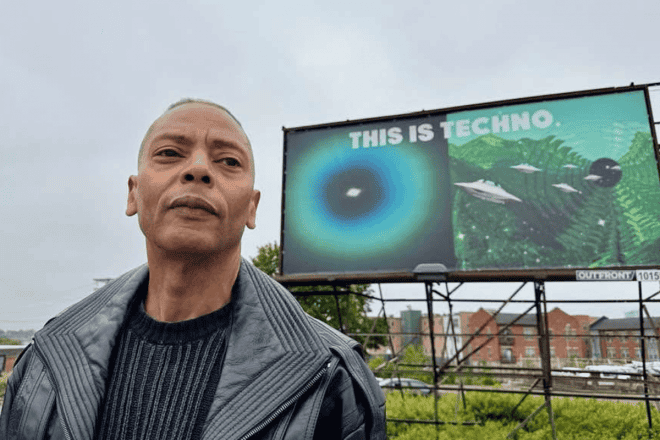Jeff Mills Plants Bold “THIS IS TECHNO” Billboards Across Detroit Streets
Detroit techno legend Jeff Mills launches provocative billboard campaign asking "THIS IS TECHNO" across three major city avenues to define authentic electronic music.

Last Updated: ()
Jeff Mills’ billboards in Detroit: “THIS IS TECHNO”. His urban art sparks debate on authenticity, legacy, and how we define electronic music today.
Bu gönderiyi Instagram’da gör
Techno Pioneer Questions Genre Authenticity Through Urban Art Installation
Jeff Mills has turned Detroit’s streets into his canvas, installing four striking billboards that pose a simple yet profound question to anyone passing by: “THIS IS TECHNO“. The legendary producer and Axis Records founder planted these visual statements across Jefferson Avenue, Gratiot Avenue, and Woodward Avenue, challenging both residents and visitors to examine what truly defines the electronic music genre that put Detroit on the global map.
The billboards feature futuristic imagery arranged in diptych format, creating an immediate visual impact that stops traffic and sparks conversation. But Mills isn’t just making a statement — he’s starting a dialogue about musical authenticity in an era where genre lines blur more than ever before.
What Makes Techno Real? Mills Asks Detroit to Listen Closer
“‘This Is Techno’ works as both a phrase and a question“, Mills explained about his street-level intervention. “It speaks to the senses we use when deciding what feels authentic versus what doesn’t.” The campaign targets the very heart of how we process and categorize electronic music, pushing people to develop sharper listening skills.
Mills designed this public art project to function beyond typical advertising. The billboards serve as a translation method that operates outside verbal communication, aligning with how technology shapes our daily interactions. Each billboard location was chosen deliberately — these three Detroit avenues carry heavy foot and vehicle traffic, ensuring maximum exposure for Mills’ musical manifesto.
The timing couldn’t be more relevant. As electronic music continues expanding globally, sub-genres multiply and boundaries dissolve. Mills’ hometown, Detroit, remains the birthplace of techno, yet the genre has evolved far beyond its original form. His billboard campaign asks whether that evolution preserves or dilutes techno’s core identity.
Detroit’s Techno Legacy Meets Modern Music Debates
Detroit holds an undisputed claim as techno’s birthplace, with pioneers like Juan Atkins, Derrick May, and Kevin Saunderson establishing the foundation in the 1980s. Mills emerged as part of the second wave, helping define the genre’s darker, more industrial direction through his work with Underground Resistance and later as a solo artist.
The billboard campaign arrives as Mills maintains his busy performance schedule. He recently headlined Movement Detroit, the city’s premier electronic music festival that draws tens of thousands of fans annually. His upcoming appearance at the Nuits Sonores festival in Lyon, France, continues his global mission to present authentic techno to international audiences.
These geographical connections matter for Mills’ message. Playing techno in Detroit feels different than performing the same music in European clubs or American festivals. The billboards ask whether location, history, and cultural context influence what qualifies as “real” techno.
Beyond Words: How Technology Shapes Musical Understanding
Mills’ explanation reveals deeper layers to his billboard project. He views the campaign as a method for “deciphering meanings beyond verbal or textual language, in tune with technology and our usual forms of communication“. This reflects his long-standing interest in how electronic music communicates emotions and ideas without relying on lyrics or traditional song structures.
The futuristic images accompanying the “THIS IS TECHNO” text create their own language. Viewers must interpret both visual and textual elements, much like listening to instrumental techno requires active engagement from audiences. Mills challenges people to become more sophisticated consumers of electronic music.
The billboard locations span different Detroit neighborhoods, each with distinct relationships to the city’s musical heritage. Jefferson Avenue cuts through downtown areas where many techno clubs operated during the genre’s early years. Gratiot Avenue extends into residential communities where many techno producers grew up and developed their sound. Woodward Avenue serves as Detroit’s main thoroughfare, connecting the city center to suburban areas where techno’s influence spread.
What This Means for Electronic Music’s Future
Mills’ billboard campaign raises questions that extend beyond Detroit’s city limits. As streaming platforms democratize music distribution and production software becomes more accessible, anyone can create tracks labeled as “techno“. The billboards ask whether technical ability alone creates authentic techno, or whether deeper connections to the genre’s history and philosophy are required.
The campaign also highlights ongoing tensions between commercial success and artistic integrity in electronic music. Major festivals now feature techno artists alongside pop stars and rock bands, exposing the genre to massive new audiences. Mills’ billboards seem to ask whether this mainstream acceptance strengthens or weakens techno’s original rebellious spirit.
For Detroit residents, the billboards serve as reminders of their city’s crucial role in electronic music history. For visitors, they provide education about techno’s origins and an invitation to listen more carefully. For the global electronic music community, Mills’ campaign starts necessary conversations about authenticity, evolution, and preservation of musical traditions.
The “THIS IS TECHNO” billboards will remain visible for several months, giving Detroit time to absorb and respond to Mills’ challenge. Whether the campaign changes how people hear and classify electronic music remains to be seen, but Mills has succeeded in making techno impossible to ignore on the streets where it was born.
Via Mixmag España. This English version includes additional reporting and analysis.



